Coronavirus (COVID-19): modelling the epidemic (issue no. 24)
Latest findings in modelling the COVID-19 epidemic in Scotland, both in terms of the spread of the disease through the population (epidemiological modelling) and of the demands it will place on the system, for example in terms of health care requirement.
This document is part of a collection
Coronavirus (COVID-19): modelling the epidemic in Scotland (Issue No. 24)
Background
This is a report on the Scottish Government modelling of the spread and level of Covid-19. This updates the previous publication on modelling of Covid-19 in Scotland published on 22 October 2020. The estimates in this document help the Scottish Government, the health service and the wider public sector plan and put in place what is needed to keep us safe and treat people who have the virus.
This edition of the research findings focuses on the epidemic as a whole, looking at estimates of R, growth rate and incidence as well as local measures of change in the epidemic.
Key Points
- The reproduction rate R in Scotland is currently estimated as being between 1.0 and 1.3.
- The number of new daily infections for Scotland is estimated as being between 130 and 337, per 100,000 people.
- The growth rate for Scotland is estimated as being between +1% and +5%.
- The estimated doubling time for Scotland was between 17 and 52 days.
- There was a significant increase in contacts when the schools went back (from just below 6 to 8 per day). However, the number of contacts has fallen significantly in the last two weeks (down around 17%), and is now lower than the level immediately before the schools returned by around 15%.
- There has also been a drop off in how many people are visiting different locations, particularly in the hospitality category. This suggests restrictions on households meeting and further restrictions on hospitality are having a noticeable effect that is likely to feed through to confirmed cases over the next week.
- Modelled rates per 100K indicate that by the week of 8 - 14 November, 23 local authorities have at least a 75% probability of exceeding
50 cases, 20 have at least a 75% probability of exceeding 100 cases, 12 have at least a 75% probability of exceeding 300 and 7 of those have at least a 75% probability of exceeding 500.
Overview of Scottish Government Modelling
Epidemiology is the study of how diseases spread within populations. One way we do this is using our best understanding of the way the infection is passed on and how it affects people who catch it to create mathematical simulations. Because people who catch Covid-19 have a relatively long period in which they can pass it on to others before they begin to have symptoms, and the majority of people infected with the virus will experience mild symptoms, this "epidemiological modelling" provides insights into the epidemic that cannot easily be measured through testing e.g. of those with symptoms, as it estimates the total number of new daily infections and infectious people, including those who are asymptomatic or have mild symptoms.
Modelling also allows us to make short-term forecasts of what may happen with a degree of uncertainty. These can be used in health care and other planning. The modelling in this research findings is undertaken using different types of data which going forward aims to both model the progress of the epidemic in Scotland and provide early indications of where any changes are taking place.
Modelling outputs are provided here on the current epidemic in Scotland as a whole, based on a range of methods. Because it takes a little over three weeks on average for a person who catches Covid-19 to show symptoms, become sick, and either die or recover, there is a time lag in what our model can tell us about any re-emergence of the epidemic and where in Scotland this might occur. However modelling of Covid deaths is an important measure of where Scotland lies in its epidemic as a whole. In addition the modelling groups which feed into the SAGE consensus use a range of other data along with deaths in their estimates of R and growth rate. These outputs are provided in the first part of this research findings. The type of data used in each model to estimate R is highlighted in Figure 2.
A short term forecast of the number of cases in the next two weeks is also provided, as the focus at this stage of the epidemic is the re-emergence of the virus in Scotland.
A new tranche of results are provided from the Scottish Contact Survey (SCS), to indicate how people's contacts are changing.
What the modelling tells us about the epidemic as a whole
Figure 1 shows how Rt has changed since February. Before the "stay at home" restrictions were put in place Rt was above 1, and most likely to have been between 3 and 4 before any interventions were put in place.
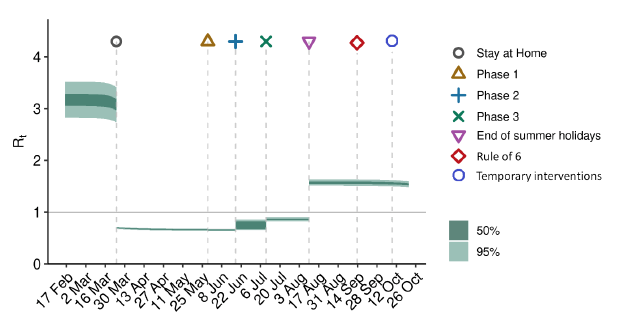
Source: Scottish Government modelled estimates using Imperial College model code; actual data from https://www.nrscotland.gov.uk/statistics-and-data/statistics/statistics-by-theme/vital-events/general-publications/weekly-and-monthly-data-on-births-and-deaths/deaths-involving-coronavirus-covid-19-in-scotland
The various groups which report to the Scientific Pandemic Influenza Group on Modelling (SPI-M) use different sources of data in their models (i.e. deaths, hospital admissions, cases) so their estimates of R are also based on these different methods. SAGE's consensus view across these methods, as of 28 October, was that the value of Rt in Scotland was above 1, between 1.0 and 1.3, meaning that the epidemic is growing exponentially. The R value estimated by the Scottish Government is higher this week, this is due to deaths, which are used in this model, lagging cases (Figure 2).
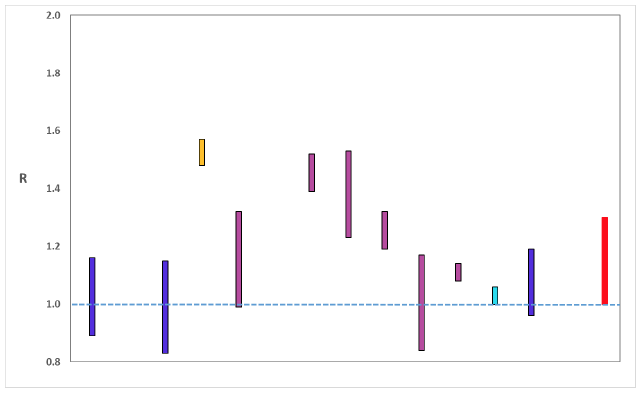
Source: Scientific Advisory Group for Emergencies (SAGE).
On 26 October, Public Health Scotland recorded 1,327[1] positive new cases, with 8,153 positive new cases over the week of 20 – 26 October.
The various groups which report to the Scientific Pandemic Influenza Group on Modelling (SPI-M) use different sources of data in their models to produce estimates of incidence. SPI-M's consensus view across these methods, as of 28 October, was that the incidence of new daily infections in Scotland was between 130 and 337 new infections per 100,000. This equates to between 7,100 and 18,400 people becoming infected each day in Scotland.
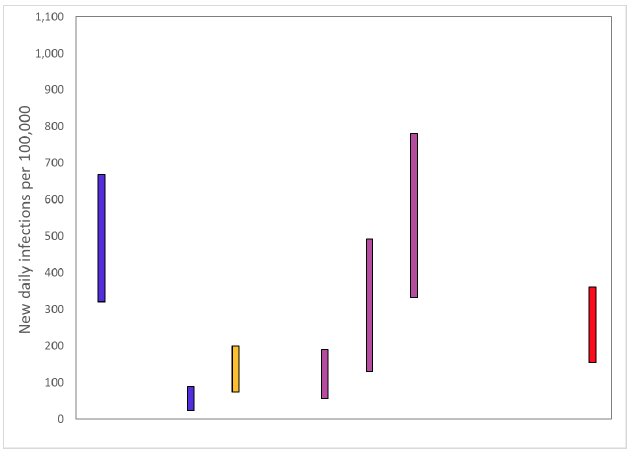
Source: Scientific Pandemic Influenza Group on Modelling (SPI-M).
The consensus from SAGE for this week is that the growth rate in Scotland is between +1% and +5% per day. Last week the growth rate was in the range +4% to +7%.
The spread of the epidemic can be expressed in terms of the length of time it takes for numbers of new daily cases to double. Doubling times were provided by SPI-M on 28 October. The consensus estimated doubling time for Scotland was between 17 and 52 days.
Figure 4 shows the epidemiological model forecasts of daily deaths produced by the Scottish Government, given the present set of interventions. This measure of the epidemic is forecast to increase in the weeks ahead.
Figure 4. Scottish Government short-term forecast of the number of deaths from Covid-19 in Scotland, based on actual data (20 October).

Source: Scottish Government modelled estimates using Imperial College model code; actual data from https://www.nrscotland.gov.uk/statistics-and-data/statistics/statistics-by-theme/vital-events/general-publications/weekly-and-monthly-data-on-births-and-deaths/deaths-involving-coronavirus-covid-19-in-scotland
The logistical model developed by Scottish Government to assess implications for health care demand (see previous Research Findings) has been adapted to produce a short/medium-term predictions of infections.
The following two week prediction uses this model to extend the estimated number of infections from the Imperial College model, in a manner that fits with the estimated number of actual infections, adjusting people who have tested positive to account for asymptomatic and undetected infections.
Figure 5 shows a "better scenario", which assumes the current Rt value was reduced significantly as a result of measures announced on 7 October, and a "worse scenario", which assumes that transmission decreased by a smaller amount. In comparison to this chart in previous versions of this paper, a calculation has been applied to data on people who have tested positive to correct for weekend effects in testing, in order to better estimate actual new infections.
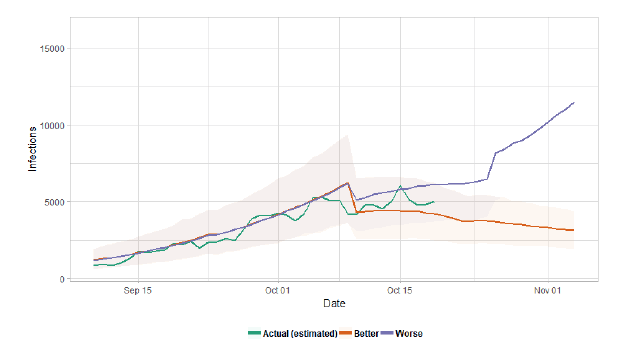
What the modelling tells us about Hospital bed and ICU bed demand
Figure 6 shows the impact of the better and worse scenarios on the number of people in hospital. As figure 5 shows, infections appear to be following a path between the worse and better scenario, and the trajectory of the hospital bed demand is likely to follow suit.
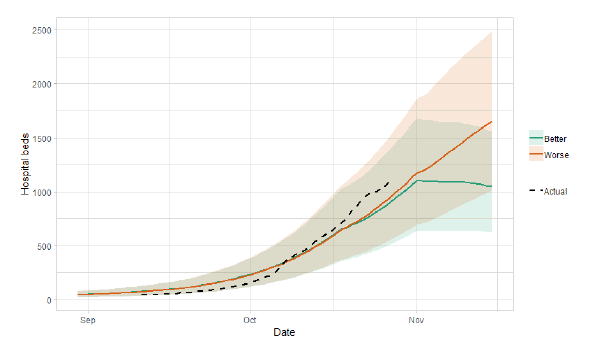
Figure 7 shows the impact of the better and worse scenarios on ICU bed demand. As things stand, the bed demand estimates lie consistently above the actual number of people in ICU, though it is well within the prediction interval.
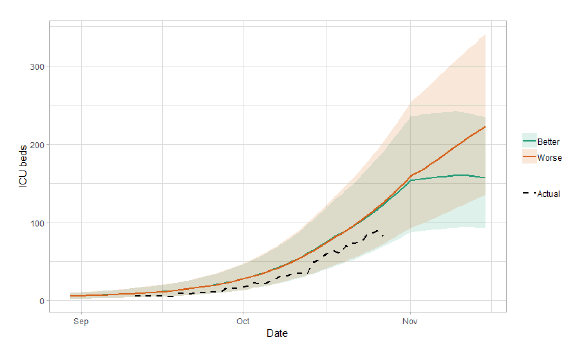
What we know about how people's contact patterns have changed
It is now possible for us to estimate how much contact people in Scotland have with each other, with a good degree of accuracy. This provides an update of the modelled results presented in issue 22 using methodologies developed by the London School of Hygiene and Tropical Medicine. The modelling is based on a survey asking about where respondents have been and how many contacts they met in a given week.
The average number of contacts per day are approximately two thirds higher than the level at the beginning of Stay-at-home-advice, and around half the level pre-Stay-at-home-advice (UK comparison 10.8). There was a significant increase in contacts when the schools went back (from just below 6 to 8 per day). However, the number of contacts has fallen significantly in the last two weeks (down around 17%), and is now lower than the level immediately before the schools returned (Figure 8) by around 15%. There has also been a drop off in how many people are visiting different locations, particularly in the hospitality category. This suggests restrictions on households meeting and further restrictions on hospitality are having a noticeable effect that is likely to feed through to confirmed cases over the next week.
From the results older people generally have fewer contacts than younger people, but the difference is largely from work and school contacts, rather than in the home or in other settings.
Although the mean number of contacts per person in the latest wave (15 to 21 October) of the SCS has reduced as shown in Figure 8, it remains significantly higher than the 2.8 contacts per person for the UK as a whole at the beginning of Stay-at-home-advice.
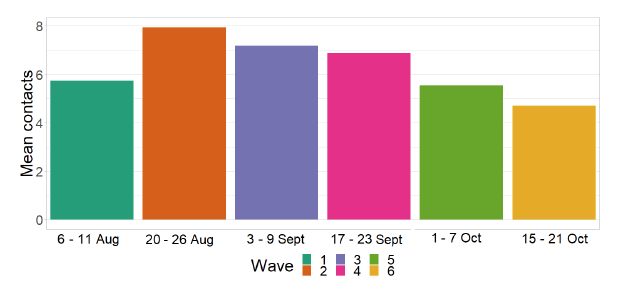
As shown in Figure 9, contacts are fewer in older age groups, with the oldest age group having similar levels of contact to the UK during Stay-at-home-advice (2.0 from CoMix), and the youngest age group having similar levels of contact to the UK average prior to Stay-at-home-advice (12.1 from POLYMOD[2]) until mid-September, although this fell significantly at the start of October and remains the same for the most recent survey.
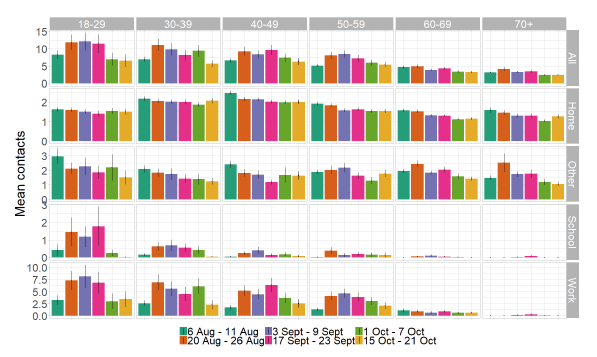
The main difference between age groups is that younger people are having more contacts at work and at school however, the latest reporting week shows a significant drop in work contacts for the 30-39 age group. There is little difference in between age groups in the number of contacts reported in "other" settings at around 1.5 contacts per day, and the youngest and oldest age groups also report similar contacts in the home (the middle age groups report higher contacts in the home than the youngest and oldest) as set out in Figure 9.
As Figure 10 shows, there has been a reduction in the proportion of people that have visited other people's homes since the first wave of the survey until the start of October, however this has levelled out in the past two weeks. This is also reflected in the mean contacts in the home in Figure 9. The most significant decrease can be seen in the number of people visiting pubs which will be largely due to the restrictions placed on hospitality, introduced on 9 October.
There had been a slight increase in the number of people travelling to work and to gyms and sports clubs, but this has reduced again in the most recent wave (after the introduction of the rule of six and restrictions on meeting in other people's households).
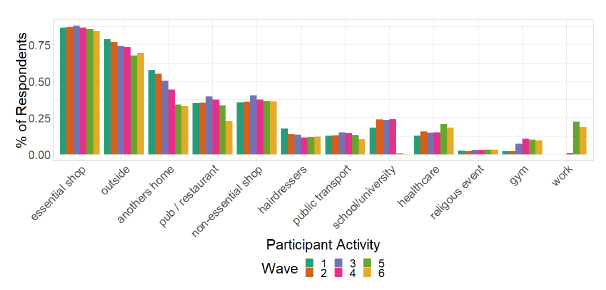
What we know about which regions are experiencing high levels of Covid
We use modelling based on Covid cases and deaths, conducted by Imperial College London, to give us an indication of whether a local authority is experiencing high levels of Covid. The model projects the epidemic two weeks into the future and computes probabilities of areas being hotspots at certain thresholds, where an area is defined as a hotspot if the cases (positive tests) per 100K population exceed a threshold, e.g. 500 weekly cases.
Modelled cases per 100K (Figure 11) indicate that by the week of 8 - 14 November, 23 local authorities are projected to have at least a 75% probability of exceeding 50 cases, 20 of those have at least a 75% probability of exceeding 100 cases, 12 of those have at least a 75% probability of exceeding 300 cases and 7 of those have at least a 75% probability of exceeding 500.
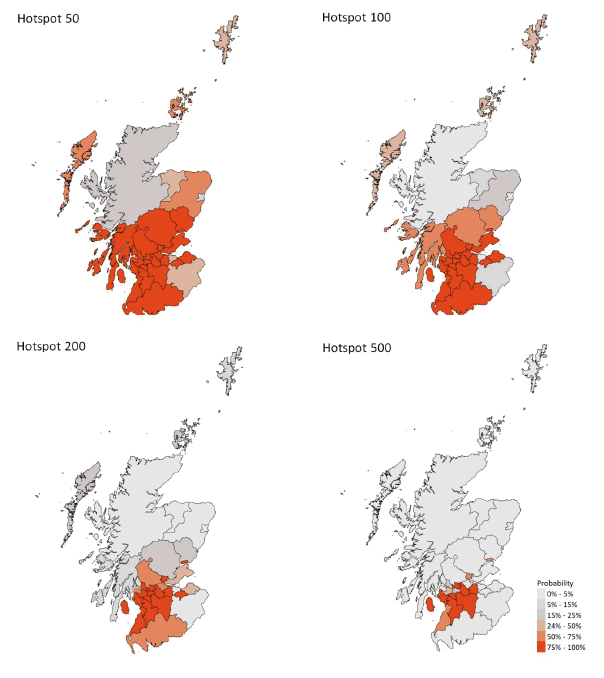
Note: Hotspot 200 is included, rather than Hotspot 300 which will be in future research findings.
What next?
The Scottish Government continues to work with a number of academic modelling groups to develop other estimates of the epidemic in Scotland. This includes updates to the forecast of the number of hospitalisations and the pattern of positive tests in different age and clinical risk groups which were reported in issue 23. This has not been included in this issue as the proportions have changed very little this week. We will provide an update when we see a significant change.
The modelled estimates of the numbers of new cases and infectious people will continue to be provided as measures of the epidemic as a whole, along with measures of the current point in the epidemic such as exceedance. Rt and growth rate will also be provided. Further information can be found at https://www.gov.scot/coronavirus-covid-19.
Technical Annex
The Imperial College London results were computed using Epidemia, which extends the Bayesian semi-mechanistic model proposed in Flaxman, S., Mishra, S., Gandy, A. et al[4].
The model is based on a self-renewal equation which uses a time-varying reproduction number R to calculate the infections. However, due to a lot of uncertainty around reported cases in the early part of epidemics, they use reported deaths to back-calculate the infections as a latent variable. Then the model utilises these latent infections together with probabilistic lags related to SARS-CoV-2 to calibrate against the reported deaths and the reported cases since the beginning of June 2020. A detailed mathematical description of the original model is available[5]. The model used is an evolution of this original model, incorporating randomness in the infections to account for areas with small numbers of infections.
R for each local authority is parameterized as a linear function of the R for its region as a whole (which it is fitted to), and a random effect specific to the local authority for each week over the course of the epidemic. The weekly random effects are encoded as a random walk, where at each successive step the random effect has an equal chance of moving upward or downward. Only a region-specific weekly random walk is used. For more information, and limitations of the projections, consult the Imperial College London web page[6].
Table 1 provides the underlying data used in the section above on "What we know about which regions are experiencing high levels of Covid". It is provided by Imperial College London.
| LA | P(Cases>500) | P(Cases>300) | P(Cases>100) | P(Cases>50) |
|---|---|---|---|---|
| Aberdeen City | 0% | 0% | 2% | 11% |
| Aberdeenshire | 0% | 1% | 23% | 67% |
| Angus | 0% | 4% | 73% | 96% |
| Argyll and Bute | 0% | 2% | 53% | 85% |
| City of Edinburgh | 0% | 0% | 2% | 28% |
| Clackmannanshire | 71% | 95% | 100% | 100% |
| Dumfries and Galloway | 1% | 27% | 88% | 97% |
| Dundee City | 56% | 92% | 100% | 100% |
| East Ayrshire | 80% | 95% | 100% | 100% |
| East Dunbartonshire | 89% | 99% | 100% | 100% |
| East Lothian | 0% | 16% | 88% | 98% |
| East Renfrewshire | 82% | 99% | 100% | 100% |
| Falkirk | 2% | 39% | 97% | 100% |
| Fife | 0% | 4% | 93% | 100% |
| Glasgow City | 19% | 85% | 100% | 100% |
| Highland | 0% | 0% | 1% | 17% |
| Inverclyde | 1% | 18% | 91% | 99% |
| Midlothian | 4% | 47% | 98% | 100% |
| Moray | 0% | 0% | 12% | 44% |
| Na h-Eileanan Siar | 2% | 7% | 40% | 59% |
| North Ayrshire | 98% | 100% | 100% | 100% |
| North Lanarkshire | 88% | 99% | 100% | 100% |
| Orkney Islands | 3% | 9% | 40% | 58% |
| Perth and Kinross | 1% | 6% | 57% | 87% |
| Renfrewshire | 47% | 81% | 99% | 100% |
| Scottish Borders | 0% | 0% | 12% | 49% |
| Shetland Islands | 1% | 4% | 28% | 47% |
| South Ayrshire | 52% | 93% | 100% | 100% |
| South Lanarkshire | 81% | 98% | 100% | 100% |
| Stirling | 2% | 20% | 89% | 98% |
| West Dunbartonshire | 21% | 71% | 99% | 100% |
| West Lothian | 79% | 98% | 100% | 100% |
Tables 2 and 3 provide the underlying data used in the section above on "What the modelling tells us about Hospital bed and ICU bed demand". They are based on modelling undertaken by Scottish Government (for more information see research findings issue 1).
| Area | 02/11/2020 | 09/11/2020 | 16/11/2020 | 23/11/2020 | 30/11/2020 | 07/12/2020 |
|---|---|---|---|---|---|---|
| Ayrshire & Arran | 18 | 21 | 25 | 32 | 42 | 55 |
| Borders | 1 | 1 | 1 | 1 | 2 | 2 |
| Dumfries & Galloway | 2 | 3 | 3 | 4 | 6 | 8 |
| Fife | 5 | 5 | 6 | 8 | 11 | 14 |
| Forth Valley | 7 | 9 | 10 | 13 | 17 | 22 |
| Grampian | 3 | 3 | 4 | 5 | 6 | 8 |
| Greater Glasgow & Clyde | 50 | 60 | 70 | 90 | 118 | 155 |
| Highland | 2 | 2 | 2 | 3 | 4 | 5 |
| Lanarkshire | 50 | 60 | 69 | 89 | 117 | 154 |
| Lothian | 17 | 21 | 24 | 31 | 41 | 54 |
| Orkney | 0 | 0 | 0 | 0 | 0 | 0 |
| Shetland | 0 | 0 | 0 | 0 | 0 | 0 |
| Tayside | 9 | 10 | 12 | 15 | 20 | 27 |
| Western Isles | 0 | 0 | 0 | 0 | 1 | 1 |
| Area | 02/11/2020 | 09/11/2020 | 16/11/2020 | 23/11/2020 | 30/11/2020 | 07/12/2020 |
|---|---|---|---|---|---|---|
| Ayrshire & Arran | 130 | 157 | 184 | 241 | 318 | 419 |
| Borders | 6 | 7 | 8 | 10 | 14 | 18 |
| Dumfries & Galloway | 18 | 22 | 26 | 34 | 44 | 58 |
| Fife | 34 | 40 | 48 | 62 | 82 | 108 |
| Forth Valley | 52 | 63 | 74 | 97 | 128 | 168 |
| Grampian | 19 | 23 | 27 | 35 | 46 | 61 |
| Greater Glasgow & Clyde | 367 | 442 | 520 | 678 | 898 | 1181 |
| Highland | 11 | 13 | 16 | 21 | 27 | 36 |
| Lanarkshire | 364 | 439 | 516 | 674 | 892 | 1173 |
| Lothian | 127 | 154 | 180 | 236 | 312 | 410 |
| Orkney | 1 | 1 | 1 | 1 | 2 | 2 |
| Shetland | 0 | 1 | 1 | 1 | 1 | 2 |
| Tayside | 63 | 76 | 89 | 117 | 154 | 203 |
| Western Isles | 2 | 2 | 3 | 3 | 4 | 6 |
Contact
There is a problem
Thanks for your feedback